Rheological Behavior of Castor Oil: Shear Stress Dependence Shear Rate
Ioana Stanciu
Abstract
In this paper, new rheological models for castor oil are proposed. The aim of this study was to find a linear, exponential, and polynomial dependence between shear stress and shear rate of castor oil using tree equation. Equation constants , A, B, and C were determined by fitting linear, exponential, and polynomial. The castor oil has been evaluated using a Haake VT 550 Viscotester developing shear rates in the range of 3-120 s-1 and measuring viscosities from 104-106 mPa·s when the HV1 viscosity sensor is used. The castor oil of the dependence shear rate decreases with increasing shear stress at a constant temperature.
Key words: castor oil, rheology, oil
Introduction
Mechanical systems often use lubricants, most of which are petroleum-based, in order to decrease component friction and surface wear. Nowadays, due to the rising of petroleum-based oil prices, the diminishing supplies of natural resources, global climate change, and increased environmental sensitivity, several alternatives for petroleum-based lubricants are now being assessed, including plant-based lubricants and synthetic lubricants (Jaghoubi, 2019). Oils and fats of plant and animal origin were extensively used as lubricants till the middle of the 19th century. Plant oils are generally attractive substitutes for petroleum-based oils as they are readily biodegradable, less toxic, renewable, and environmentally friendly (Khanh et al., 2020).
Plant oils have good potential for various industrial applications and positive production trends. The oilseed production is on the rise worldwide, but now, it is more expensive than petroleum-based oils. When the life cycle advantages of plant-based lubricants are considered, economic losses are justified (Conningham et al., 2004). From both production and life cycle standpoints, the future seems optimistic for plant oils as a viable replacement for petroleum-based lubricants. In general, when compared with mineral oil base stokes, plant oils have the following advantages: higher viscosity index, lower evaporation loss, and enhanced lubricity, which leads to improved energy efficiency. However, plant oils have functional limitations, especially in hydrolytic, oxidative, and thermal stability (Adhvaryu et al., 2004). Plant oils normally contain ~80-95% fatty acids, as major performance improvers in lubricants (Fox et al., 2004). Moreover, mineral oils normally contain saturated aliphatic compounds, namely naphthenic and paraffinic, and a small amount of aromatics. Thereby, the stability of mineral oils is more than plant oils due to their chemical nature; nonetheless, they have lower lubricity (Nariman, 2012). Plant oils are generally very good boundary lubricants but their high-pressure behavior has not been studied accurately. In this research, some high-pressure tribological properties of plant oils were measured and their effect on lubrication was compared (Ohno, 2007). Temperature-pressure-viscosity, as well as temperature-pressure-density relations, are essential to know the lubricating oil performance at high-pressure conditions. Coconut oil, mustard oil, camellia oil, rapeseed oil, olive oil, and castor oil, are considered as testing lubricating oil among plant oils. Plant oils have a high viscosity index, as an important characteristic of lubricant. While low-temperature properties are not sufficiently good as mineral oil, especially coconut oil showed the highest solidification temperature (Alshareef and Ibrahim, 2020). Solidification temperature was measured at atmospheric pressure by a low-temperature test using liquid nitrogen. The pressure-viscosity coefficient α of these oils has been measured by measuring the viscosity at different pressures. Density was measured by a high-pressure densitometer at various temperatures. Comparing all results, plant oils showed better properties at 40-60°C. Due to the considerable pressure-viscosity coefficient, it can be utilized in elastohydrodynamic lubrication. Plant oils would be the alternate of mineral oils.
The fatty acid composition in the weight percentage of castor oil is given in Table 1. Among the fatty acids, stearic acid, palmitic acid, lauric acid, capric acid, caprylic acid, and myristic acid are saturated fatty acids.
Whereas, oleic acid, ricinoleic acid, gadoleic acid, and erucic acid are the monounsaturated fatty acids but linoleic acid and linolenic acid are polyunsaturated fatty acids.
Table 1: Fatty acid composition of castor oil
|
Fatty acid |
castor oil |
|
C8 Caprylic |
- |
|
C10 Capric |
- |
|
C12 Lauric |
- |
|
C14 Myristic |
- |
|
C16 Palmitic |
1.1 |
|
C18 Stearic |
1.0 |
|
C18:1 Oleic |
4.1 |
|
C18:1+H |
88 |
|
Ricinoleic |
- |
|
C18:2 Linoleic |
4.8 |
|
C18:3 |
0.5 |
|
Linolenic |
- |
|
C20:1 Gadoleic |
- |
|
C22:1 Erucic |
- |
|
Other |
0.7 |
The object of this study was to determine the rheological behaviour for castor oil at shear rates ranging between 3 and 120 s-1 and temperatures between 40 and 100oC. This study was done to find a linear, exponential, and polynomial dependence on shear stress and shear rate for castor oil. The oil modified Andrade equation was studied. Constants , A, B, C and correlation coefficient were determined by correlating a characteristic exponential and equations of each curve for castor oil (Stanciu, 2019; Stanciu, 2018; Stanciu, 2018; Stanciu, 2018).
Material and Methods
The castor oil used in this work was provided from a company in Bucharest, Romania, and was studied with no additives. It was evaluated using a Haake VT 550 Viscotester developing shear rates in a range from 3 to 120s-1 and its viscosity was measured from 104 to 106 mPa.s when the HV1 viscosity sensor was used. The temperature ranged from 40 to 100°C and was measured 10°C intervals. The accuracy of the temperature was 0.1°C.
Results and Discussion
The dependency of shear stress on the shear rate for castor oil at 40, 50, 60, 70, and 80°C (the black curves in Fig. 1, 2, 3, 4, and 5, respectively) was fitting linear as shown in figures 1, 2, 3, 4 and 5, respectively.
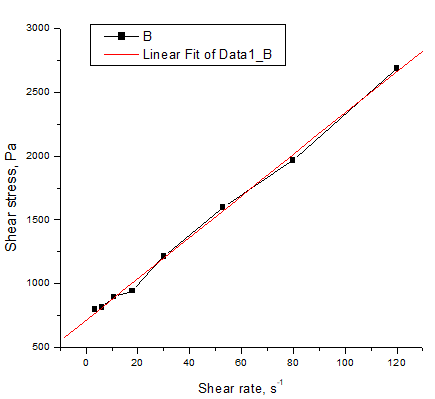
Fig. 1: Rheogram of castor oil at 40°C
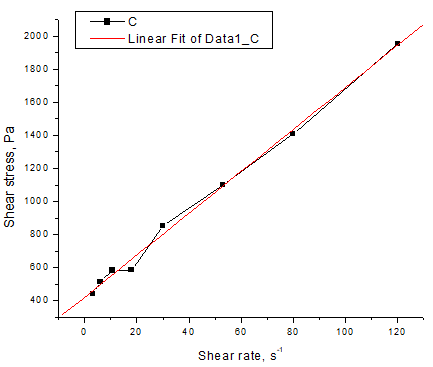
Fig. 2: Rheogram of castor oil at 50°C
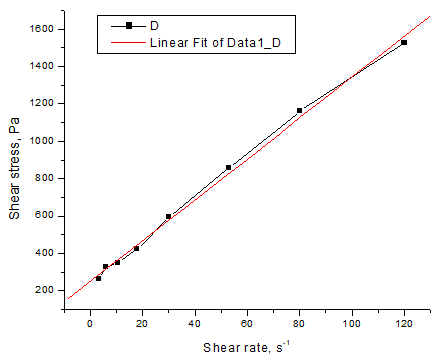
Fig. 3: Rheogram of castor oil at 60°C
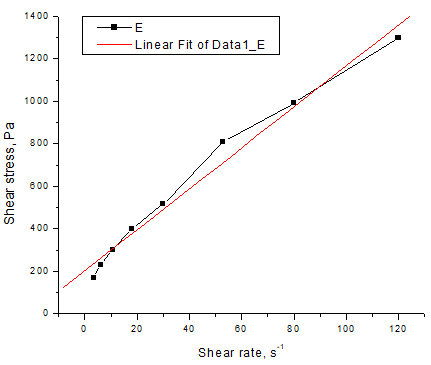
Fig. 4: Rheogram of castor oil at 70°C
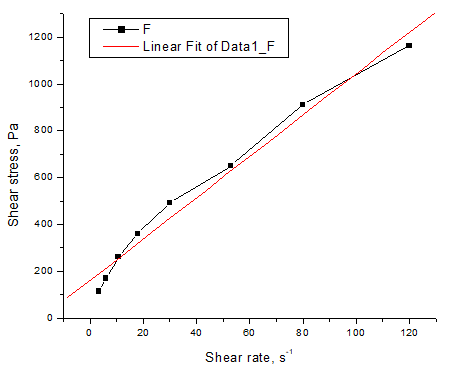
Fig. 5: Rheogram of castor oil at 80°C
In this article, three relations of dependence on the shear rate were proposed depending on the shear voltage. By linear, exponential, and polynomial fits, we found the following relations:
 (1)
(1)
 (2)
(2)
 (3)
(3)
Tables 2, 3, and 4 show the values of parameters described by the equations (1), (2), and (3) castor oil and correlation coefficient, R2.
Table 2. The temperature, value of the parameters described by equation (1), and coefficient correlation for castor oil
|
Temperature, °C |
Value of parameters |
Correlation coefficient, R2 |
|
|
A |
B |
||
|
40 |
16.2771 |
711.9302 |
0.9988 |
|
50 |
12.7109 |
420.3463 |
0.9978 |
|
60 |
10.9279 |
249.4705 |
0.9982 |
|
70 |
9.6132 |
203.8444 |
0.9911 |
|
80 |
8.8389 |
161.1127 |
0.9897 |
|
90 |
6.6635 |
153.2452 |
0.9715 |
|
100 |
5.9124 |
103.0524 |
0.9789 |
In Table 2, the parameters A and B decrease with increasing oil temperature. Their values are influenced by the chemical structure of oil and the conditions under which they were determined.
Table 3. The temperature, value of parameters described by equation (2), and coefficient correlation for castor oil
|
Temperature, °C |
Value of parameters |
Correlation coefficient, R2 |
||
|
A |
B |
C |
||
|
40 |
724.5639 |
15.3375 |
0.0080 |
0.9978 |
|
50 |
421.6347 |
12.6151 |
8.1756E-4 |
0.9955 |
|
60 |
223.2569 |
12.8775 |
-0.0166 |
0.9988 |
|
70 |
145.6798 |
13.9389 |
-0.0369 |
0.99719 |
|
80 |
108.4131 |
12.7583 |
-0.0334 |
0.9940 |
|
90 |
82.5695 |
11.9197 |
-0.0449 |
0.9880 |
|
100 |
50.3706 |
9.8304 |
-0.0334 |
0.9899 |
In Table 3, the parameters A, B, and C decrease with increasing oil temperature. Their values are influenced by the chemical structure of oil and the conditions under which they were determined.
Table 4. The temperature, value of parameters described by equation (3), and coefficient correlation for castor oil
|
Temperature, °C |
Value of parameters |
Correlation coefficient, R2 |
||
|
|
A |
B |
||
|
40 |
4.1645E6 |
-4.1638E6 |
255778.6399 |
0.9975 |
|
50 |
756507.8217 |
-756087.3942 |
59431.1527 |
0.9955 |
|
60 |
4553.8205 |
-4330.9559 |
333.9558 |
0.9988 |
|
70 |
1985.2165 |
-1847.7774 |
123.2755 |
0.9977 |
|
80 |
1787.8899 |
-1688.4209 |
122.0136 |
0.9948 |
|
90 |
1005.9358 |
-947.2226 |
63.2374 |
0.9926 |
|
100 |
926.4400 |
-892.4730 |
75.4256 |
0.9937 |
In Table 4, parameters , A, and B decrease with increasing oil temperature. Their values are influenced by the chemical structure of oil and the conditions under which they were determined.
Conclusions
This article presented three relations of the dependence of the shear rate on the shear voltage obtained by the linear, exponential, and polynomial fit of the experimental curves. The correlation coefficients showed values close to the unit for all temperatures at which the oil was studied.
References
Adhvaryu A., Erhan S. Z. & Perez J. M. (2004). Tribological Studies of Thermally and Chemically Modified Plant Oils for Use as Environmentally Friendly Lubricants, Wear, 257(3-4), 359-369.
Alshareef A A & Ibrahim M. (2020). Neuroprotective Effect of Virgin Coconut Oil Against Hydrocarbon Induced Neurotoxicity . Pharmacophore, 11(2), 95-99.
Conningham B., Battersby N., Wehmeyer W. & Fotherg C. (2004). A Sustainability Assessment of a Biolubricant. J. of Industrial Ecology., 7(3-4), 179-192.
Fox N. J., Tyrer B. & Stachowiak G. W. (2004). Boundary Lubrication Performance of Free Fatty Acids in Sunflower Oil. Tribology Letter., 16(4), 275-281.
Jaghoubi S. (2019). Oil Price Shocks, Stock Market Behavior, And Portfolio Risk Management: Evidence From Major Oil Importing - Exporting Markets. Journal of Organizational Behavior Research, 4(2), 2019-234.
Khanh, T. H., Ban, P. H., & Hoi, T. M. (2020). Constituents of essential oils from the leaf, fruit, and flower of Decaspermum parviflorum (Lam.) J. Scott. Archives of Pharmacy Practice, 11(1), 88-92.
Nariman A. (2012). Effects of Temperature on Rheology of Olive Oils. Applied Rheology, 22(3), 342031-342037.
Ohno N. (2007). High-pressure behavior of toroidal CVT fluid for automobile, Tribology Internationa., 40(2), 233-238.
Stanciu I. (2018). Models rheological mathematical of dependence dynamic viscosity – shear rate for soybean oil, Journal of Science and Arts., 4(45), 1001-1006.
Stanciu I. (2018). Rheological study behavior of soybean oil. Journal of Science and Arts., 3(44), 711-716.
Stanciu I. (2018). Rheology behavior of soybean oil, Journal of Science and Arts., 2(43), 453-458.
Stanciu I. (2019). Rheological investigation of soybean oil from soya beans. Journal of Science and Arts.,4(49), 938-988.

